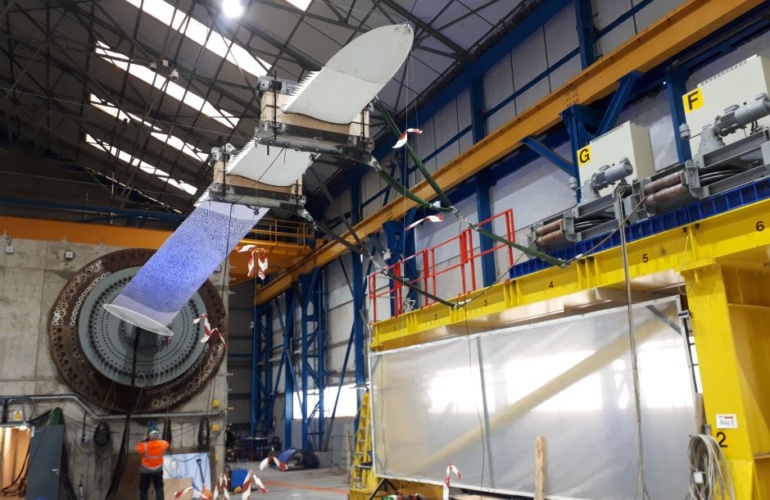
Developed by Edinburgh-based ACT Blade, the new technology involves replacing the heavier glass fibre design traditionally used for wind turbine blades with a lighter composite structure, wrapped in a sail-like textile.
FASTBLADE composite structures test facility takes shape at Rosyth
Scotland's Lightweight Manufacturing Centre (LMC), together with the University of Sheffield’s Advanced Manufacturing Research Centre (AMRC) and the Offshore Renewable Energy (ORE) Catapult, is supporting ACT Blade to develop the blade and bring it to market.
A lighter blade is claimed to allow for 10 per cent more length, which, in turn, generates up to nine per cent more energy from the same wind turbine. The technology could be a disruptor for the offshore wind industry, helping to make offshore wind more economical and easier to harness.
Prof. Iain Bomphray, Director of the Lightweight Manufacturing Centre, said: “This is the first of its kind in the world. ACT Blade has developed an entirely new type of blade made of composite materials and a textile shell that offers significant cost and sustainability benefits. Manufacturing costs are also 30 per cent lower than for conventional blades and they don’t require finishing and painting, which is a time consuming and polluting process. The blade is also partly recyclable.
“We were keen to apply the lightweighting expertise and experience we have here at the LMC to the ACT Blade concept, also helping the team to design, test and ultimately manufacture this innovative technology.”
The prototype was completed in February 2020 and in April, ACT Blade announced that it had completed static tests at ORE Catapult’s National Renewable Energy Centre in Blyth. The blade is now undergoing testing of one million cycles in each direction.
Dr Sabrina Malpede, ACT Blade CEO, said: “This ultralight blade has the potential to be completely disruptive to the renewables sector, allowing for substantial cost savings and increased production of wind energy. Working with the LMC has allowed us to tap into its composite capabilities and take our ACT Blade concept from design through to manufacture. Now, we need to see how it performs in a real environment.”
Lightweighting is the process of making products or parts lighter to reduce costs, energy expenditure and carbon emissions. The principles are of interest across multiple sectors from aerospace and automotive to defence and renewables.
“Wind energy is a natural energy source but even this clean energy source can be made even more sustainable still, by reducing the carbon footprint associated with the manufacture and transport of parts and by making the harnessing of the energy more efficient,” said Bomphray.
The Lightweight Manufacturing Centre is a specialist technology centre in the National Manufacturing Institute Scotland (NMIS) and operated by Strathclyde University.




First seven members join NG’s Great Grid Partnership
Agreed. It is all pretentious posturing and trite branding with no meaning or gravitas. Prepare to be disappointed by all of these greats/grates.